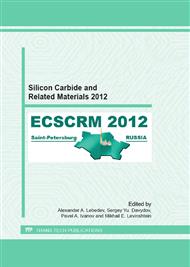[10]
µm Fig. 2 Optical micrograph of epitaxial layers grown from CH4.
Fig. 3 Optical micrograph of epitaxial layers grown from standard precursors.
From experiments it is observed that growth rates are similar for C3H8 and CH4, but that the surface morphology is worse for CH4 (at the same inlet C/Si ratio). It is also known that the morphology becomes worse at higher C/Si ratios (for the same precursor). In Fig. 2 and Fig. 3 optical micrographs of epitaxial layers grown from different carbon precursors are shown, where the difference in surface morphology is clearly shown. One explanation, if the simulation results are correct, could be that the carbon content over the wafer area changes dramatically when CH4 is used, from relatively low rates in the upstream region to relatively high rates downstream. Upstream there would thus be a silicon rich environment, while there would be a carbon rich environment downstream. For C3H8, the carbon deposition rate is more uniform, which would imply that similar conditions prevail over the entire wafer area, making it easier to optimize process parameters for good surface morphology. In addition, in real growth runs, more parasitic growth is observed in the wafer area when using CH4, as compared to other carbon precursors. This could also be explained by the results here; the model predicts a large amount of "extra" carbon in the wafer area that is not matched by the amount of silicon. Thus, one might expect more non-stoichiometric SiC deposition in this area. Conclusions It can be concluded from the results presented here that the more detailed model used in the simulations may explain some of the experimentally observed differences between the two carbon precursors studied. It is also concluded that the five most important species that act as carbon source are similar to what has been shown in the literature, except for the CH2 molecule, which has not been reported as significant earlier. Silicon limited growth is predicted by the more detailed model, whereas carbon limited growth is predicted with the previous model. The difference between the results from the two models is the predicted amount of available molecules at the growth surface. Summary A first step towards a general model for CVD growth of SiC, valid for any range of process parameters and choice of precursors, is taken. Mainly the hydrocarbon chemistry has been studied by a detailed gas-phase reaction model, and comparison has been made between C3H8 and CH4 as carbon precursors. The results indicate that experimentally observed differences, which previous models have been unable to predict, may be explained by the new model. Acknowledgements Support from the Swedish Foundation for Strategic Research (project SM11-0051) is gratefully acknowledged. References
Google Scholar


